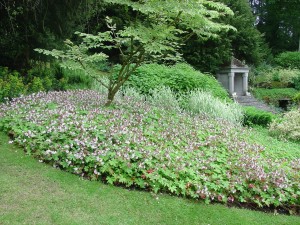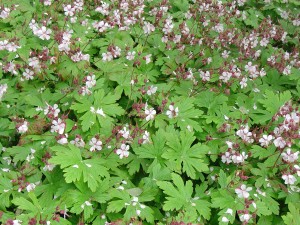Bigroot geranium (Geranium macrorrhizum), aka “cranesbill”, is a clump-forming perennial ground cover from Southern Europe (USDA Zones 3–8). It is one of the easiest geraniums to grow. Plants spread by thick rhizomes to form a dense ground cover. Individual plants grow 12 to 18 inches high and 18-24 inches spread.
The 1-inch wide, 5-petaled dark purplish pink (magenta) flowers appear in late spring. This cranesbill often re-blooms in summer. Flowers give way to cranesbill-like seed heads. Deeply lobed palmate, deeply-lobed (5 – 7 lobes), medium green leaves (basal leaves may be 4 – 8 inches wide) are hairy, sticky and fragrant when crushed. Leaves take on an attractive bronze tint in fall. Foliage forms an attractive ground cover throughout the summer and fall. Leaves are also fragrant when crushed. Species is called “bigroot geranium” in reference to its thick, fleshy rhizomes.
Bigroot geranium is easily grown in average, dry to medium, well-drained soils and in full sun to partial shade. One year established are very drought tolerant and hold up to summer heat better than most Geranium spp. Raise the height of the lawn mower to 9 – 12 inches high and mow over the planting to removal of spent flower seedheads to obtain an attractive plant appearance and slow possibilities of self-seeding. Feed lightly with 10-10-10 or equivalent fertilizer in early spring.
In general, geraniums as a group have few serious insect or disease problems. Poorly drained, infertile soil and extreme weather conditions will slow down this otherwise carefree ground cover. Rabbits and deer usually leave it alone
Plant this as a reliable ground cover in partially shaded areas of flower garden or around the base of recently planted trees. It grows aggressively, easily naturalizes, and chokes out weeds.
Leading Varieties:
‘Bevan’s Variety’ is a popular cultivar; it tends to grow an inch or two taller than the species and is slightly more vigorous.
‘Ingwersen’s Variety’ has light pink flowers and slightly glossier leaves.



 Posted in
Posted in 
